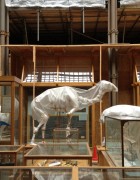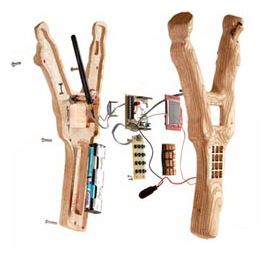Eva Hornecker was in town and came to talk about her work on embodied responses to data experience and Trevor Hogan’s research into tactile data. The main question seemed to be: how does embodiment effect experience and how can we capture these experiences? More specifically, how do people experience data and how can we design for embodied data experiences? The researcher in this context examines current and retrospective accounts of experience. Eva referred to ways of eliciting responses as belonging to a ‘psycho-phenomenological approach’ to design research with a focus on what Dourish calls ‘the creation, manipulation, and sharing of meaning through engaged interaction with artefacts’. There is a wealth of existing theoretical work in this area and a rich tradition in HCI research that looks at how people experience computer interfaces. Dag Svanaes has written about the relationship between computers and embodiment in the context of healthcare, Thecla Schiphorst is a well-known name in the field of embodied cognition and how technology mediates representation of the body, Daniel Fallman at Umea is an important voice in the connection between a phenomenological view of experience and the doing of design.
Eva introduced us to a way of doing design research called the repertory grid. The repertory grid technique dates to the mid 50’s and George Kelly‘s work in how personality is constructed. Repertory Grid technique is described as idiographic, a Kantian term meaning it is concerned with the specific, contingent, and subjective qualities of experience. More specifically, devising a repertory grid for design research means doing factor analysis which involves cross correlating assigned values in a statistical construct. The researcher is looking for a minimum context triad by which two elements are seen to be similar or different to a third. The values expressed by the grid emerge from interview data and transcripts of focus group sessions and are held to be representative of qualitative responses from participants. The grid thus allows for an increasingly refined definition of what people mean by certain terms such as ‘uncomfortable’ or ‘familiar’. My understanding of the way this is used in design research is evaluative rather than generative. Participants are asked to describe the qualities of a particular experience – in this case a novel interface – these qualities are then triangulated for reliability.
For my own research the repertory grid is perhaps a less appropriate method since I am less concerned with evaluating existing interfaces and more with the qualities necessary for participants to construct narrative accounts of their own mental models where these involve digital systems. Eva did end with a pertinent question for me though: What do other modalities express in terms of experience and what effect do they have? My research so far has involved participants drawing comic books and creating physical models of their social networks. What might adding sound, touch or texture add to how the artefacts are created or experienced? Two questions remain for me about the work Eva showed us. Firstly, it did not seem to take account of Stuart Reeves et al’s work on a taxonomy for performative interfaces and how they effect the user experience. Secondly, it was less interested in allowing participants to create visualisations or manifestations for themselves and privileged the artist/designer/researcher as sole author of mediating artefacts.
Video of the talk is here.
Top Image: Trevor Hogan, Solar Dowsing Rod



